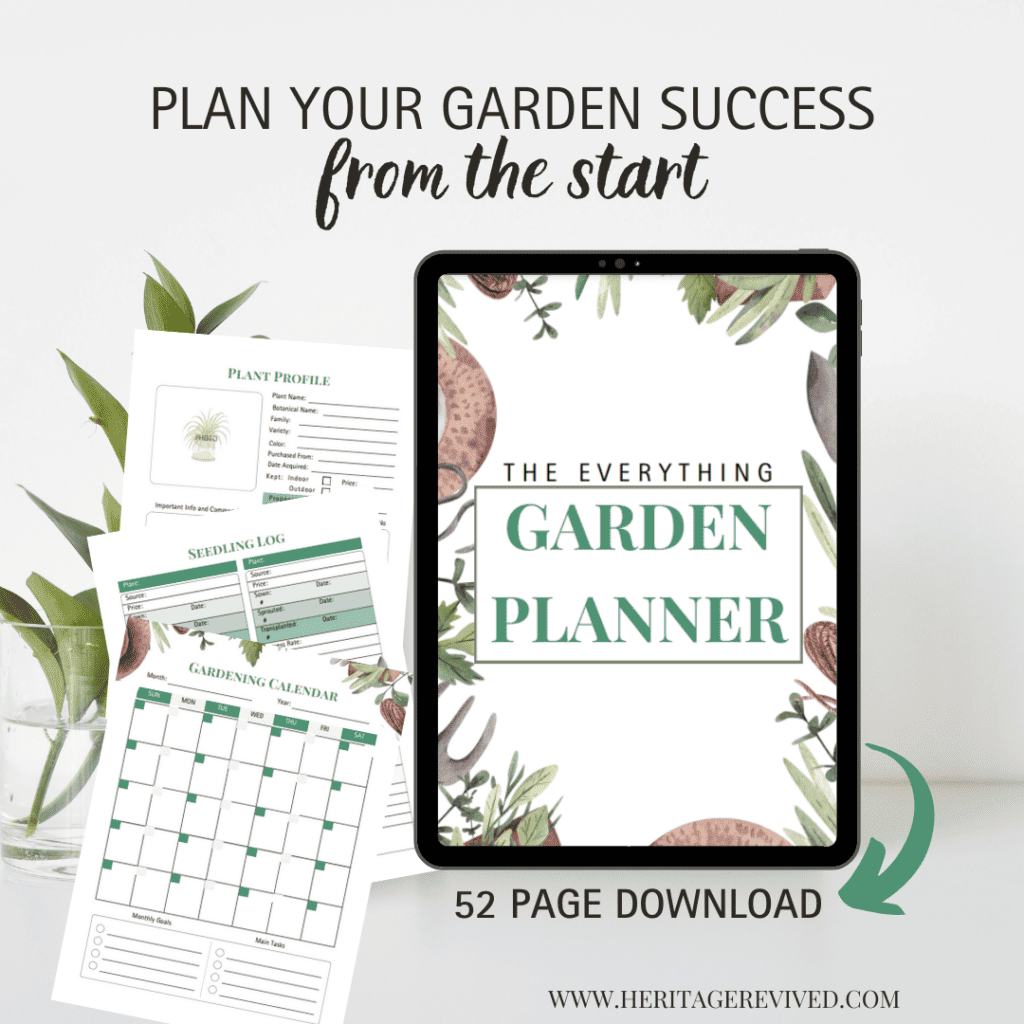If you’re planning your first big garden, you might be wondering how to preserve vegetables without refrigeration so that you can enjoy them longer.
When I was a new gardener, I had just a few containers of tomatoes and lettuce, so preserving our summer veggies was never an issue. We quickly ate whatever we grew.
When we started to expand our garden, though, I had to learn some new ways to “put up” the garden bounty.
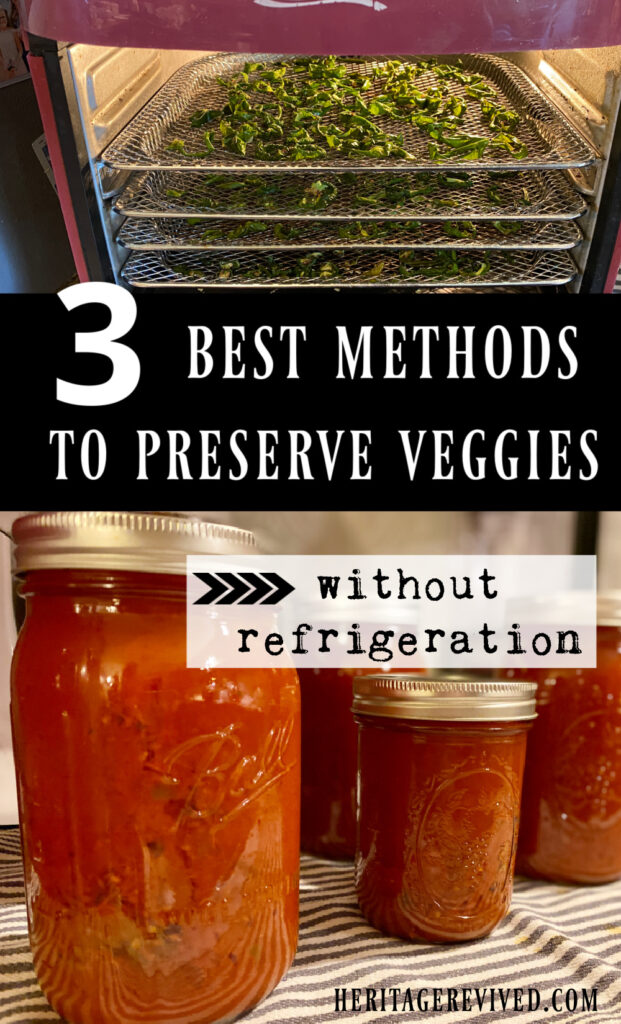
There’s a learning curve to any type of home food preservation, but I’ve found it a fun challenge to learn as many methods as possible.
Don’t have a garden yet? By learning how to store vegetables without refrigeration, you can still:
- Make the most of store-bought produce
- Preserve deeply discounted veggies from farmers markets, auctions etc.
- Preserve “freebie” veggies given to you by friends
- Become less reliant on the grocery store by making fewer trips for fresh produce
- Be more prepared for power outages as you’ll have vegetables to eat that don’t rely on the fridge or freezer
The benefits are numerous, so let’s dig into how to preserve those veggies, however you come by them!
This site contains affiliate links to products. As an Amazon associate, I earn from qualifying purchases. Please read my disclosure for more info.
Vegetables that do not need to be refrigerated
First, we should talk about which veggies actually need refrigerated and which ones don’t.
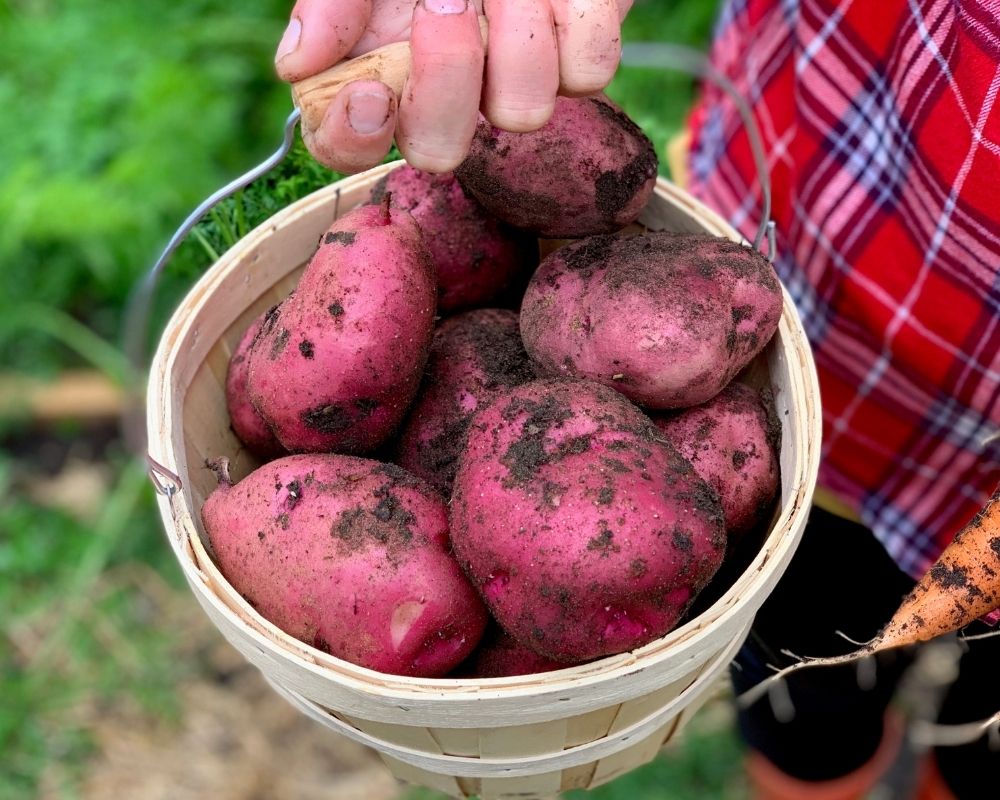
The following vegetables are actually best kept outside the fridge:
- Root veggies like potatoes, sweet potatoes, onions, garlic– store in a cool, dark place. Potatoes need a little humidity.
- Winter squash with thick skins (acorn, butternut, Sucrine du Berry)- stores well in a at room temperature or in a cool, dark place like the basement or pantry, with low humidity.
- Unwashed carrots, beets, turnips and parsnips can last a few days on the counter. For longer term storage, keep in boxes layered with sand, dry leaves or sawdust in the basement.
- Tomatoes (which are actually a fruit), bell peppers, avocados – can last around a week on the counter top.
Most other veggies are going to require either refrigeration, freezing OR just a little more work to preserve otherwise.
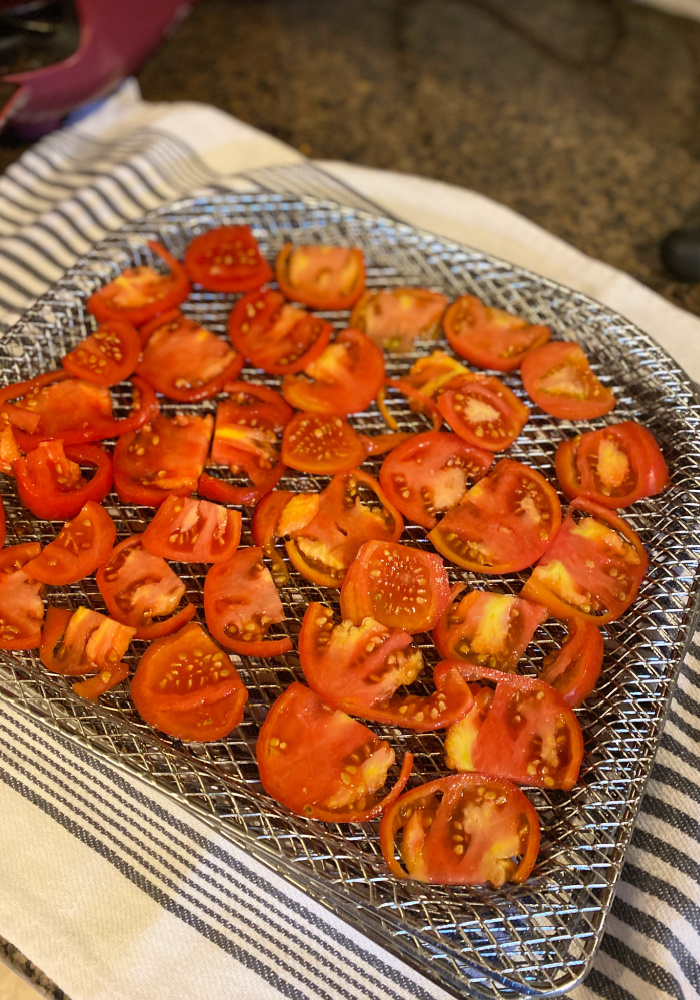
How to save vegetables – without refrigeration
Below, we’ll outline the best ways to preserve vegetables without refrigeration or freezing, for the purpose of longer term storage.
1| Canning
The best way to preserve many vegetables without refrigeration is by canning them.
This involves using glass mason jars, lids and rings, applying the appropriate heat and sanitation to prevent spoilage and producing an airtight seal in your jars.
*Note: familiarize yourself with canning processes before diving in! Your canner will come with instructions, and a good, trusted canning book such as the Ball Complete Book of Home Preserving is a great place to start.
With that said, I’ll provide a basic canning overview below (which is by no means comprehensive!).
To safely preserve vegetables, you have to understand the two recommended canning methods: boiling water canning, and pressure canning.
Method 1- Boiling Water Canning
Boiling water canning is used for higher-acid vegetables (with a pH of 4.6 or less) and fruits like tomatoes and when pickling many vegetables in a vinegar solution.
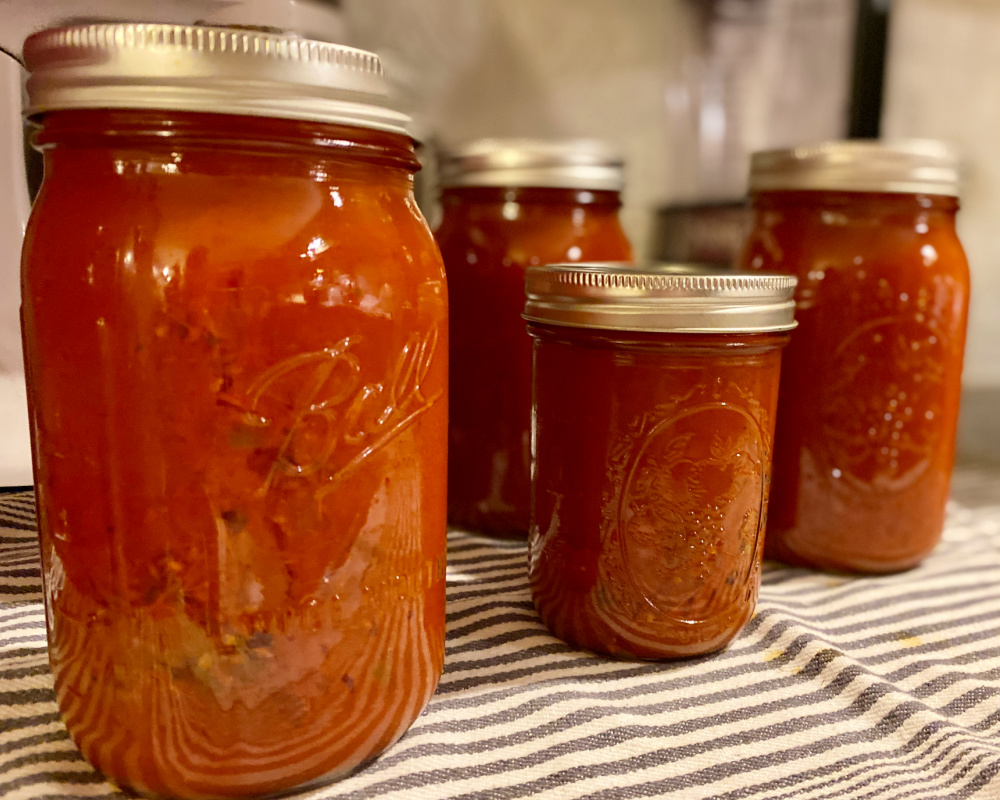
Also called “water bathing”, this method requires a large enough stockpot such as stainless steel or graniteware that can hold several canning jars at once.
You will also need a rack that keeps the jars off the bottom of the pot (many canning pots come with one).
(I prefer the stainless steel pot if you’re using a glass top stove, for more consistency while boiling. Be careful not to scratch the stovetop, though!)
Depending on what you’re preserving, boiling water canning typically requires sterilizing your jars, filling with hot product (like tomato sauce, jelly), and securing with a lid and a ring.
The jars are then lowered into your water bath with a few inches of water covering the top of the jars.
Then jars are then processed for the specified amount of time in your recipe, after the water comes to a rolling boil, then removed to cool on the counter for around 24 hours.
Read next: How to can thick tomato sauce
Method 2- pressure canning
Pressure canning is used for lower-acid vegetables (with a pH of 4.6 or more), legumes and meat. Examples: green beans, corn, peas, peppers, potatoes, squash and vegetable stock should all be pressure-canned.
It is crucial to understand that certain bacteria can still thrive in a low-acid environment even after being processed in water at boiling temperature.
This is why pressure canning is necessary; to destroy bacteria such as the spores which cause botulism.
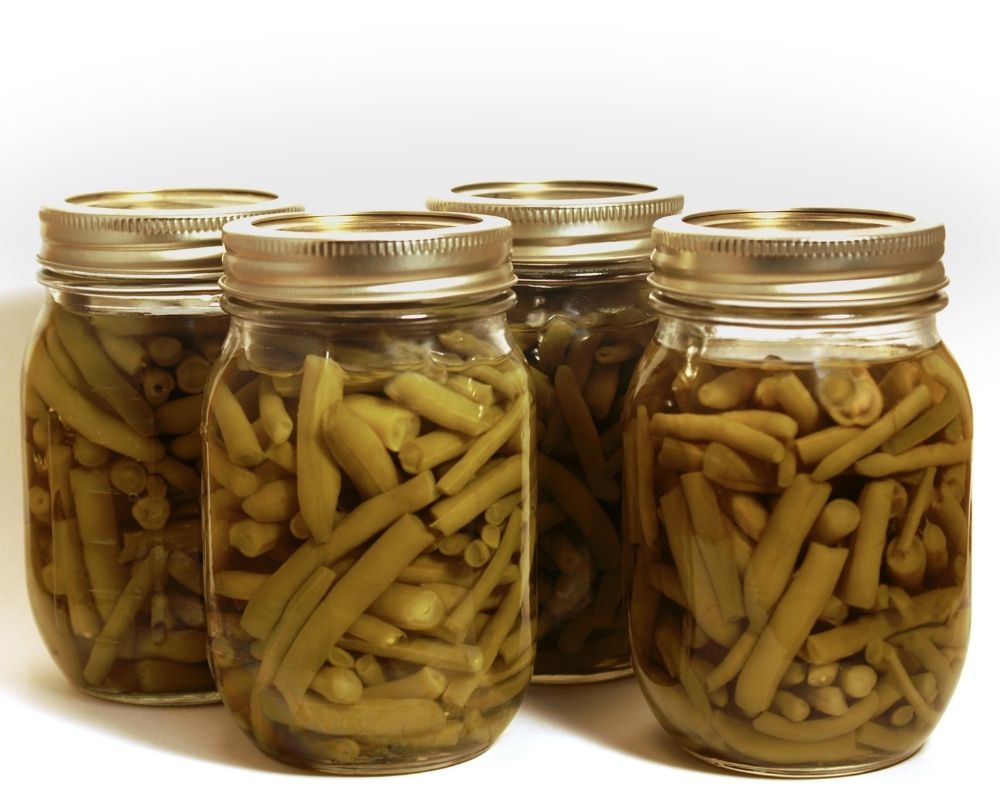
With pressure canning, like boiling water canning, you will follow your recipe for specific canning times and processing instructions.
Some vegetables can be either “hot packed”, meaning you can choose to either boil them ahead of time, or “raw-packed”, meaning you pack the jars with raw product and pour boiling water over them before processing.
Pressure Canner recommendations
There are several different kinds of pressure canners to choose from.
My #1 recommendation for those new to home canning is the Presto Digital Pressure Canner. You can also use it for water bath canning.
It takes a lot of the guesswork out of canning, with a digital screen and step-by-step prompts.
I use my digital canner weekly now, as it’s so simple to use and I don’t have to watch it as closely like a stovetop pressure canner.
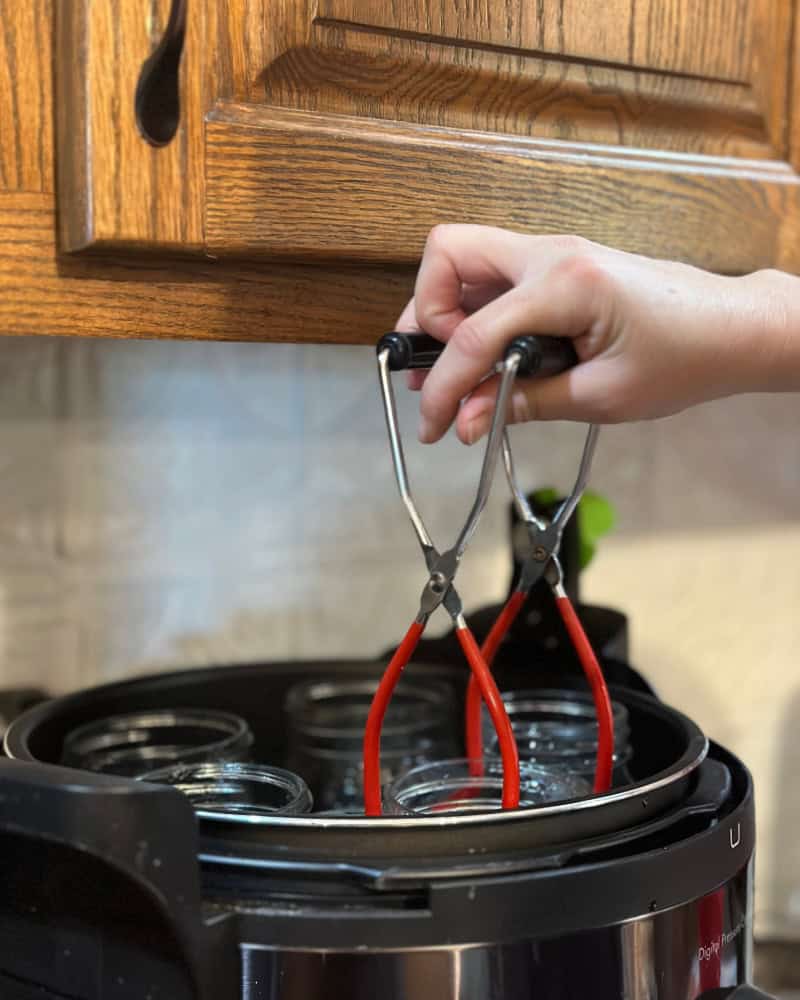
With that said, you may want a non-electric canner as a backup, or to be able to can more jars at once.
A weighted-gauge canner (versus a dial-gauge version) is considered easier to use for beginners.
Note: A pressure cooker and a pressure canner are not the same thing! You cannot use a pressure cooker (like an InstantPot) for canning.
How long do home-canned vegetables last?
Most companies that produce canning lids today rate their lids to last up to about 18 months. This means that the seal can sometimes fail after that point, by their testing standards.
Some people are comfortable going beyond that timeframe.
I typically try to only can enough product for our family to eat through the next growing season, just to be on the safe side.
Side Note: How to keep greens fresh without refrigeration
Leafy greens, as we know, don’t last outside the fridge once they’re picked from the garden or brought home from the store.
In case you’re wondering, though, they can be pressure canned, except for lettuce. Some good options for canning are:
- Spinach
- Swiss chard
- Collard greens
- Kale
You can also dehydrate or freeze dry greens using the methods outlined below.
2| Dehydration
Another way to preserve your vegetables beyond the fridge is to remove the moisture from them by dehydrating them.
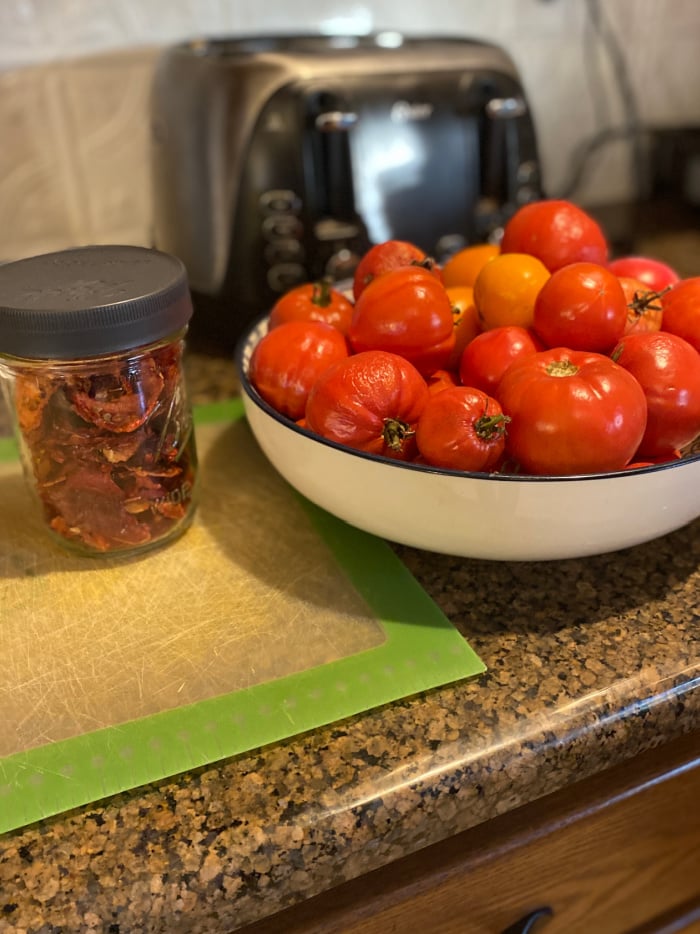
The process is fairly straightforward. You need to cut up your veggies into small pieces or slices. Then decide how you’re going to dehydrate them.
Here are a few options:
Electric dehydrator
One popular model the Excalibur dehydrator. I see the Excalibur recommended frequently for those serious about dehydrating or want to do a large volume.
The Nesco brand is another good option at a lower price.
I happened to find a PowerXL Air Fryer Pro at a garage sale last year. It has a dehydrating function, and it works amazingly well, with 5 racks that allow ample space.
I prefer using it because we can use it for so many other things in addition to dehydrating, which saves space in the kitchen.
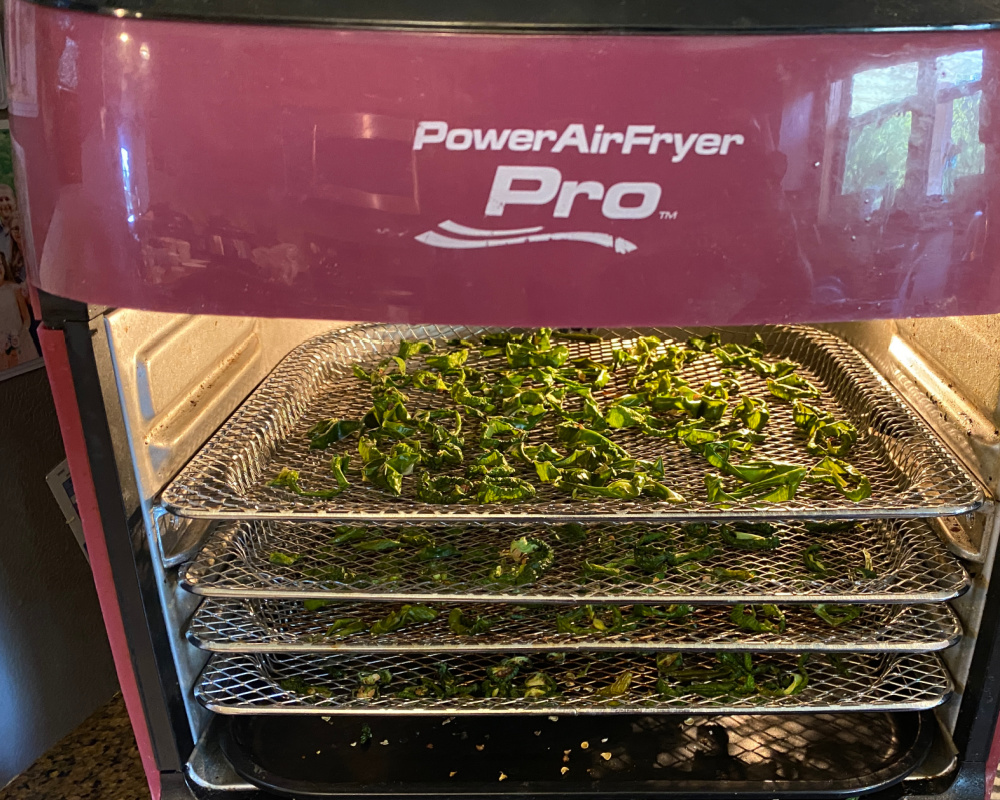
However, recently I purchased a new dehydrator. I chose one with 10 stainless steel racks because I like how easy they are to clean, and durable.
After several years of dehydrating, we decided it was time to free up our air fryer in the summer and have a stand-alone dehydrator, as we use it constantly!
I’ll provide an updated review of my new Magic Mill dehydrator soon!
Standard Oven
Most ovens do not have the low temperature required to dehydrate vegetables. I’ve found that 130-140 degrees Fahrenheit is the range you need.
In my oven, the lowest temperature is 200 degrees F, which burns the vegetables before they are dried.
However, some people have luck using their oven and cracking the door open and just monitoring it closely.
For the amount of energy that is used in a typical oven, I don’t recommend this method as it’s inefficient.
Non-electric Dehydration Methods
My grandparents’ generation used window screens to dry vegetables and fruits in the sun until dried.
There are other other outdoor methods, such as using collapsible hanging dehydrators or drying on a metal cooling rack (the kind used for baking). You can read more about solar dehydration here.
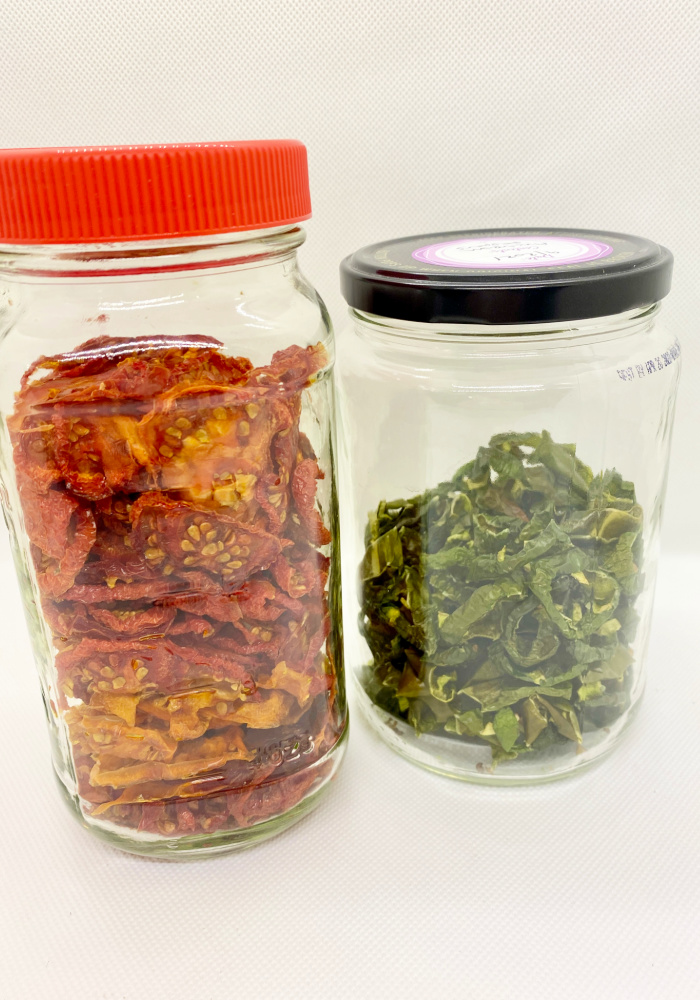
How long do dehydrated vegetables last?
In a glass jar with a lid, most properly dehydrated vegetables will last several months or more.
You can extend this a little longer by using a vacuum sealer with a mason jar lid attachment to remove the air from your storage jar.
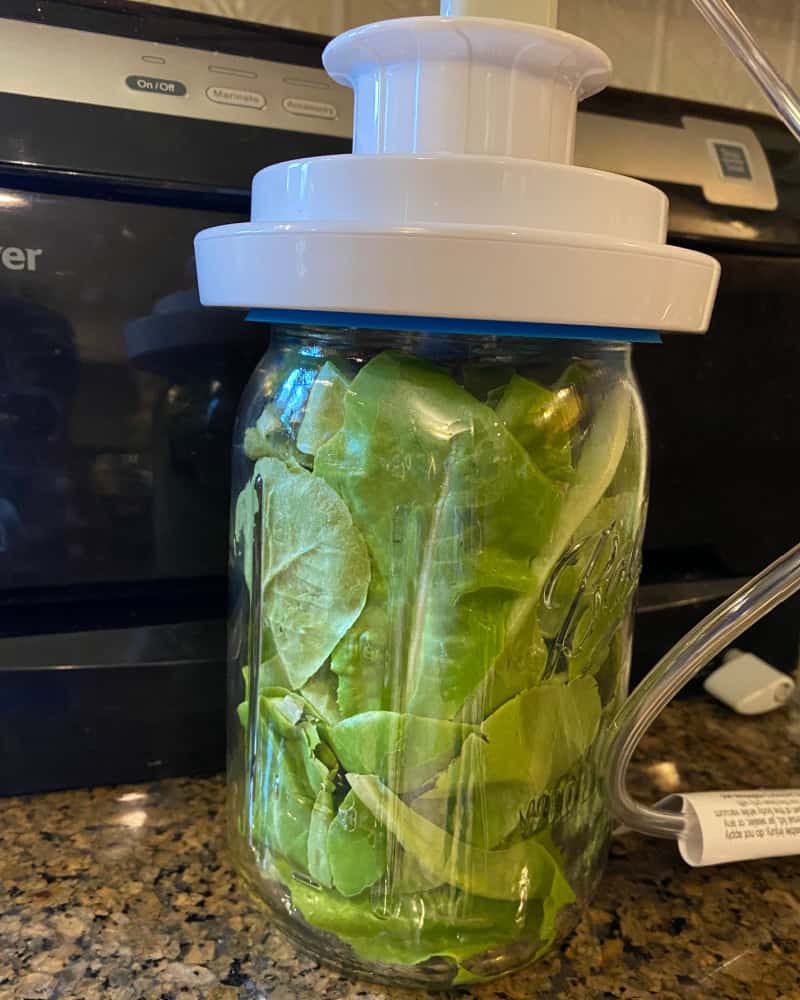
3| Freeze Drying
If you’re familiar with long-term storage companies like Augason Farms, you know that freeze dried foods can last a really long time — sometimes 20+ years if stored properly!
Because of this, freeze drying wins the prize for how to store vegetables long term. (REALLY long term, that is.)
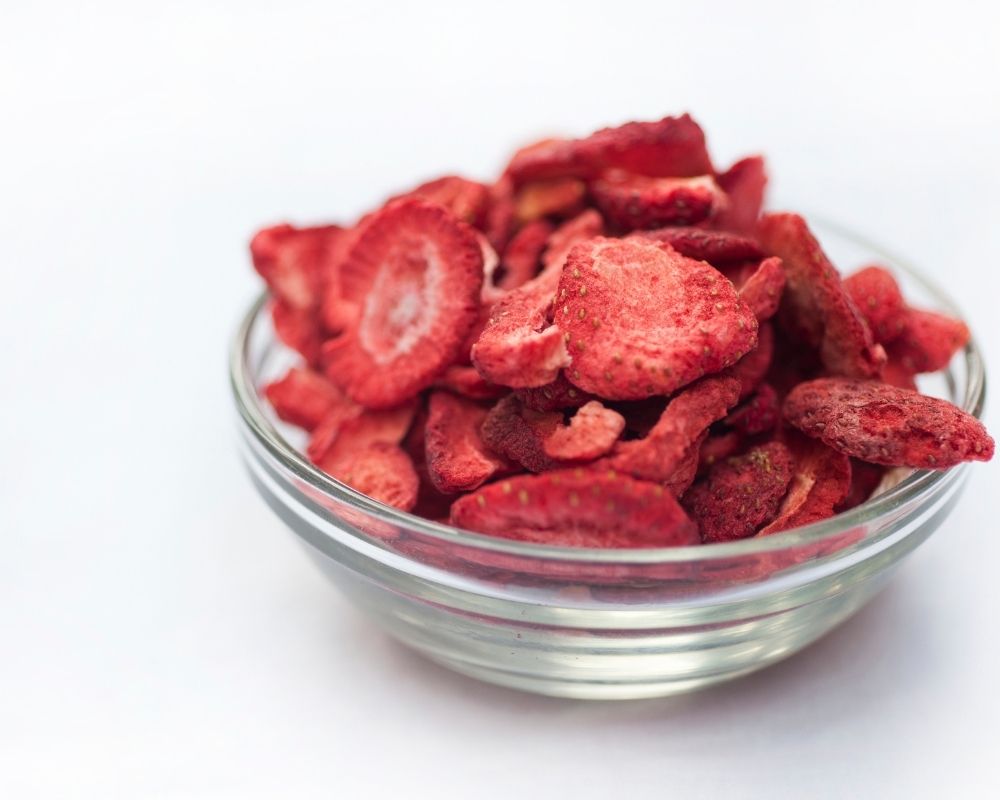
Be prepared for sticker shock, though. Freeze dryers are a huge investment for the average family.
Harvest Right is the most well-known brand, and you can expect to pay over $2,500 for the smallest model.
People who choose to go this route do rave about their machines.
They see it as cost-effective in the sense that they can preserve their garden produce (and even meats — nearly all foods) for much longer than canning or dehydrating allows.
Unconventional Methods
Lastly, while canning, dehydrating and freeze drying are considered acceptable forms of food preservation in the U.S., there are more practices that other cultures and previous generations have also used preserved vegetables.
In the book, Preserving Food Without Freezing or Canning, some of these lesser-known methods are explored in more detail.
While the techniques described in this book may not be “approved” by current USDA standards, they’re certainly interesting to read about.
And who knows, there could be some valuable information that we would all be wise to learn, in any event.
Preserving more than just food
Now that you know how to preserve vegetables without refrigeration or freezing, you can pick a skill you’d like to start with, and start practicing it!
It only takes a few months of trial and error to understand the basics of preserving vegetables, and you’ll become more confident with time.
The best part for me is opening a jar of veggies months after growing season, and enjoying the fruits of my labor, well into winter time.
Saving money in the long-run, and knowing what is in the food you’re preparing are just a few other reasons that make preserving vegetables more than worthwhile.
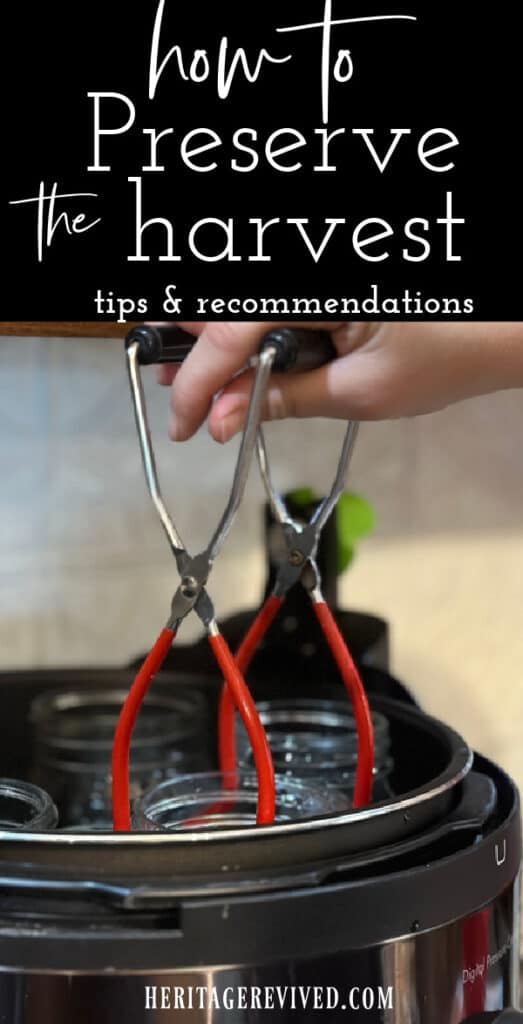
You might also like:
Preserving basil- beyond the dehydrator
How to become more self-sufficient (baby steps)
Best ways to preserve meat without refrigeration
How-to guide for canning tomato sauce WITH skins and seeds
How to make and can homemade chicken broth
